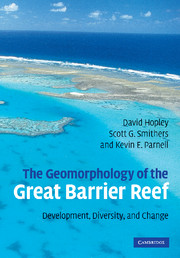Book contents
- Frontmatter
- Contents
- Preface
- Acknowledgements
- 1 Geomorphology and the Great Barrier Reef
- 2 Foundations of the Great Barrier Reef
- 3 Sea level: a primary control of long-term reef growth and geomorphological development
- 4 Oceanography, hydrodynamics, climate, and water quality as influences on reef geomorphological processes
- 5 Spatial analysis of the morphology of the reefs and islands of the Great Barrier Reef
- 6 The non-reefal areas of the continental shelf
- 7 Fringing and nearshore coral reefs
- 8 The mid-shelf reefs of the Great Barrier Reef
- 9 The coral reefs of the outer shelf of the Great Barrier Reef
- 10 Islands of the Great Barrier Reef
- 11 The accumulation of the Holocene veneer to the Great Barrier Reef
- 12 The Holocene evolution of the Great Barrier Reef province
- 13 Geomorphology's contribution to the understanding and resolution of environmental problems of the Great Barrier Reef
- References
- Geographic index
- Subject index
11 - The accumulation of the Holocene veneer to the Great Barrier Reef
Published online by Cambridge University Press: 22 August 2009
- Frontmatter
- Contents
- Preface
- Acknowledgements
- 1 Geomorphology and the Great Barrier Reef
- 2 Foundations of the Great Barrier Reef
- 3 Sea level: a primary control of long-term reef growth and geomorphological development
- 4 Oceanography, hydrodynamics, climate, and water quality as influences on reef geomorphological processes
- 5 Spatial analysis of the morphology of the reefs and islands of the Great Barrier Reef
- 6 The non-reefal areas of the continental shelf
- 7 Fringing and nearshore coral reefs
- 8 The mid-shelf reefs of the Great Barrier Reef
- 9 The coral reefs of the outer shelf of the Great Barrier Reef
- 10 Islands of the Great Barrier Reef
- 11 The accumulation of the Holocene veneer to the Great Barrier Reef
- 12 The Holocene evolution of the Great Barrier Reef province
- 13 Geomorphology's contribution to the understanding and resolution of environmental problems of the Great Barrier Reef
- References
- Geographic index
- Subject index
Summary
Introduction
In Chapters 7, 8, and 9, the morphology and evolution of reefs in three zones across the Great Barrier Reef (GBR) shelf have been presented. In part the interpretation has come from the numerous drill holes and dated core materials which have become available in the last 25 years (Tables 7.2, 8.1, and 9.1). The examples cited are but a part of the total dataset which now comprises the drilling of approximately 50 reefs (over 160 holes), a total core length of almost 2000 m through the Holocene, and almost 750 radiocarbon dates. Combined, these data are a powerful tool for the interpretation of Holocene growth patterns across the full extent of the GBR. Given the size, latitudinal, and cross-shelf extent of the GBR, results of such a synthesis may be applicable to many reef areas elsewhere for which the information is less comprehensive. Conversely, interpretations from elsewhere in the Indo-Pacific and Caribbean may be helpful in deciphering the Holocene evolution of the GBR.
Synthesizing the data, for example into growth rates during the Holocene in different environments, was an early goal of drilling in the 1970s and 1980s (Davies and Hopley, 1983; Davies et al., 1985). The dataset then was much less than now, derived from 68 holes drilled in 22 reefs, and 597 radiocarbon dates. Nonetheless, results as published in 1983 appear to be strengthened by further work and where more raw data have been added the results have not been altered significantly.
- Type
- Chapter
- Information
- The Geomorphology of the Great Barrier ReefDevelopment, Diversity and Change, pp. 367 - 410Publisher: Cambridge University PressPrint publication year: 2007



